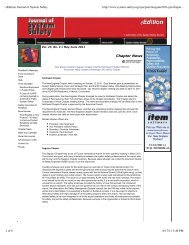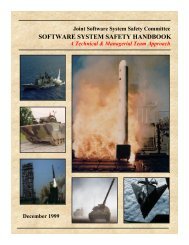Air Force System Safety Handbook - System Safety Society
Air Force System Safety Handbook - System Safety Society
Air Force System Safety Handbook - System Safety Society
You also want an ePaper? Increase the reach of your titles
YUMPU automatically turns print PDFs into web optimized ePapers that Google loves.
1.1 Definitions: <strong>System</strong> <strong>Safety</strong> and<br />
<strong>Safety</strong> <strong>System</strong>.<br />
To employ the concepts of system safety, it is necessary to<br />
understand what system safety is and what system safety<br />
strives to do.<br />
The ultimate objective of any organization within the <strong>Air</strong> <strong>Force</strong><br />
is maximizing combat capability. One element in this<br />
maximizing process is protecting and conserving combat<br />
weapon systems and their support equipment. Preventing<br />
mishaps and reducing system losses is one important aspect<br />
of conserving these resources. <strong>System</strong> safety contributes to<br />
mishap prevention by minimizing system risks due to hazards<br />
consistent with other cost, schedule, and design requirements.<br />
The fundamental objective of system safety is to identify,<br />
eliminate or control, and document system hazards. This<br />
hierarchy of goals, illustrated in Figure 1-1, is the crucial<br />
framework for defining system safety. (41:15)<br />
Figure 1-1<br />
MAX<br />
COMBAT<br />
CAPABILITY<br />
CONSERVE COMBAT<br />
RESOURCES<br />
PREVENT/MITIGATE MISHAP LOSSES<br />
EVALUATE AND MINIMIZE SYSTEM RISKS<br />
IDENTIFY, CONTROL, AND DOCUMENT SYSTEM HAZARDS<br />
<strong>System</strong> <strong>Safety</strong> Goals<br />
<strong>System</strong> <strong>Safety</strong>. The application of engineering and management<br />
principles, criteria, and techniques to optimize all aspects<br />
of safety within the constraints of operational effectiveness,<br />
time, and cost throughout all phases of the system life cycle.<br />
<strong>System</strong>. A composite, at any level of complexity, of personnel,<br />
procedures, materials, tools, equipment, facilities, and<br />
software. The elements of this composite entity are used<br />
together in the intended operational or support environment to<br />
perform a given task or achieve a specific production, support,<br />
or mission requirement.<br />
<strong>Safety</strong>. Freedom from those conditions that can cause death,<br />
injury, occupational illness, or damage to or loss of equipment<br />
or property, or damage to the environment. (30:3)<br />
CHAPTER 1<br />
INTRODUCTION TO SYSTEM SAFETY<br />
1<br />
Some clarifications are needed with these definitions. Absolute<br />
safety is not possible because complete freedom from all<br />
hazardous conditions is not possible. Therefore, safety is a<br />
relative term that implies a level of risk that is both perceived<br />
and accepted. You will also note that “system” is also a relative<br />
term. A subsystem is a system itself with predetermined<br />
boundaries. <strong>System</strong> safety is not an absolute quantity either.<br />
<strong>System</strong> safety is an optimized level of risk that is constrained<br />
by cost, time, and operational effectiveness (performance).<br />
<strong>System</strong> safety requires that risk be evaluated and the level of<br />
risk accepted or rejected by an authority. This is the basic<br />
origin of system safety’s requirement for both engineering and<br />
management functions. Finally, system safety is a discipline<br />
employed from the initial design steps through system<br />
demilitarization or disposal (a.k.a. “cradle to grave or “womb to<br />
tomb”).<br />
1.2 <strong>System</strong> <strong>Safety</strong> Objectives.<br />
A safe system is achieved through the implementation and<br />
careful execution of a system safety program. As stated previously,<br />
the ultimate objective of system safety is MAXIMIZED<br />
COMBAT CAPABILITY. The objectives of a system safety<br />
program are to ensure: (30:2)<br />
a. <strong>Safety</strong>, consistent with mission requirements is<br />
designed into the system in a timely, cost-effective<br />
manner.<br />
b. Hazards are identified, evaluated, and eliminated, or<br />
the associated risk reduced to a level acceptable to<br />
the managing activity (MA) throughout the entire life<br />
cycle of a system.<br />
c. Historical safety data, including lessons learned<br />
from other systems, are considered and used.<br />
d. Minimum risk is sought in accepting and using new<br />
designs, materials, and production and test<br />
techniques.<br />
e. Actions taken to eliminate hazards or reduce risk to<br />
a level acceptable to the MA are documented.<br />
f. Retrofit actions are minimized.<br />
g. Changes in design, configuration, or mission<br />
requirements are accomplished in a manner that<br />
maintains a risk level acceptable to the MA.<br />
h. Consideration is given to safety, ease of disposal,<br />
and demilitarization of any hazardous materials<br />
associated with the system.<br />
i. Significant safety data are documented as “lessons<br />
learned” and are submitted to data banks, design<br />
handbooks, or specifications.<br />
j. Hazards identified after production are minimized<br />
consistent with program restraints.




